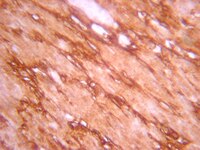07-1231 Sigma-AldrichAnti-Notch1 Antibody, Intracellular
Use Anti-Notch1 Antibody, Intracellular (Rabbit Polyclonal Antibody) validated in ELISA, WB, IHC(P) to detect Notch1 also known as Neurogenic locus notch homolog protein 1 precursor.
More>> Use Anti-Notch1 Antibody, Intracellular (Rabbit Polyclonal Antibody) validated in ELISA, WB, IHC(P) to detect Notch1 also known as Neurogenic locus notch homolog protein 1 precursor. Less<<Produtos recomendados
Panorama geral
| Replacement Information |
|---|
Tabela com principais espec.
| Species Reactivity | Key Applications | Host | Format | Antibody Type |
|---|---|---|---|---|
| H | ELISA, WB, IH(P) | Rb | Serum | Polyclonal Antibody |
| References |
|---|
| Product Information | |
|---|---|
| Format | Serum |
| HS Code | 3002 15 90 |
| Control |
|
| Presentation | Rabbit polyclonal IgG serum in buffer containing in 0.02 M Potassium phosphate, 0.15 M NaCl with 0.01% sodium azide. |
| Quality Level | MQ100 |
| Physicochemical Information |
|---|
| Dimensions |
|---|
| Materials Information |
|---|
| Toxicological Information |
|---|
| Safety Information according to GHS |
|---|
| Safety Information |
|---|
| Packaging Information | |
|---|---|
| Material Size | 200 µL |
| Transport Information |
|---|
| Supplemental Information |
|---|
| Specifications |
|---|
| Global Trade Item Number | |
|---|---|
| Número de catálogo | GTIN |
| 07-1231 | 04053252516528 |
Documentation
Anti-Notch1 Antibody, Intracellular MSDS
| Título |
|---|
Anti-Notch1 Antibody, Intracellular Certificados de análise
| Título | Número do lote |
|---|---|
| Anti-Notch 1, Intracellular | 2842910 |
| Anti-Notch 1, Intracellular - 2410224 | 2410224 |
| Anti-Notch 1, Intracellular - 2018493 | 2018493 |
| Anti-Notch 1, Intracellular - 3190920 | 3190920 |
| Anti-Notch 1, Intracellular - 3485905 | 3485905 |
| Anti-Notch 1, Intracellular - 3506695 | 3506695 |
| Anti-Notch 1, Intracellular - 3845722 | 3845722 |
| Anti-Notch 1, Intracellular - 3932194 | 3932194 |
| Anti-Notch 1, Intracellular - 4055465 | 4055465 |
| Anti-Notch 1, Intracellular - 4073640 | 4073640 |










